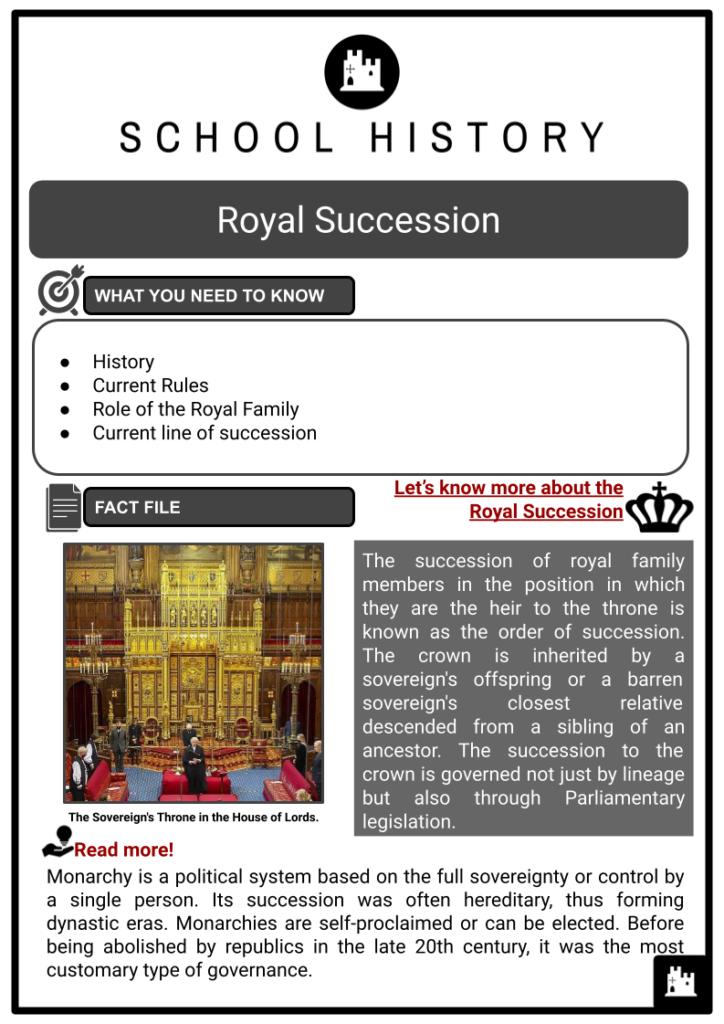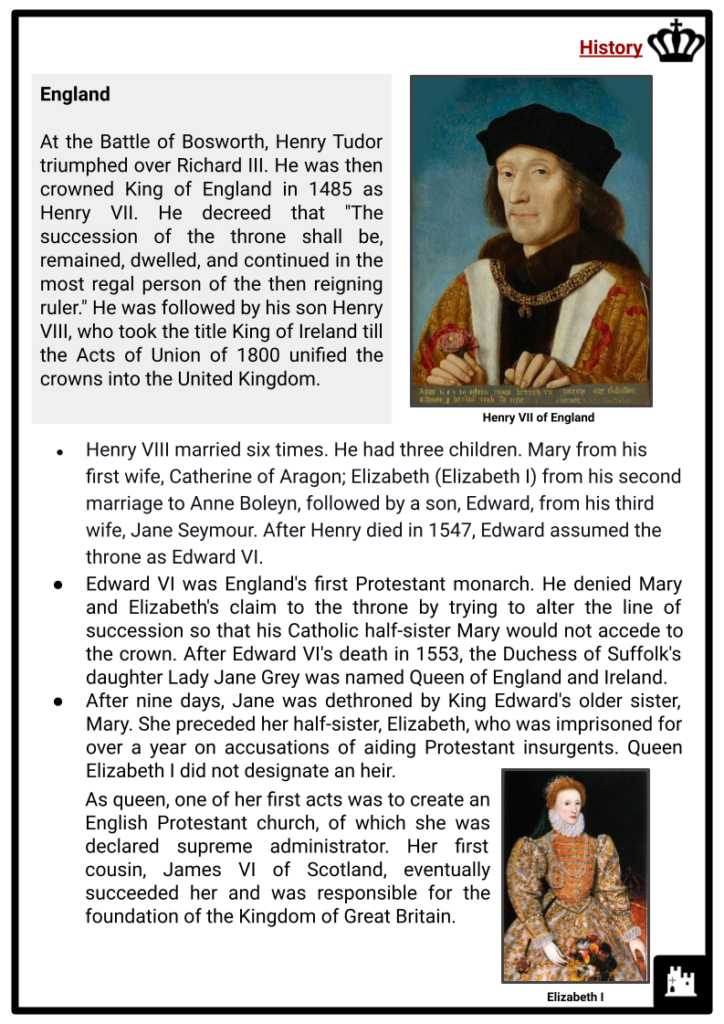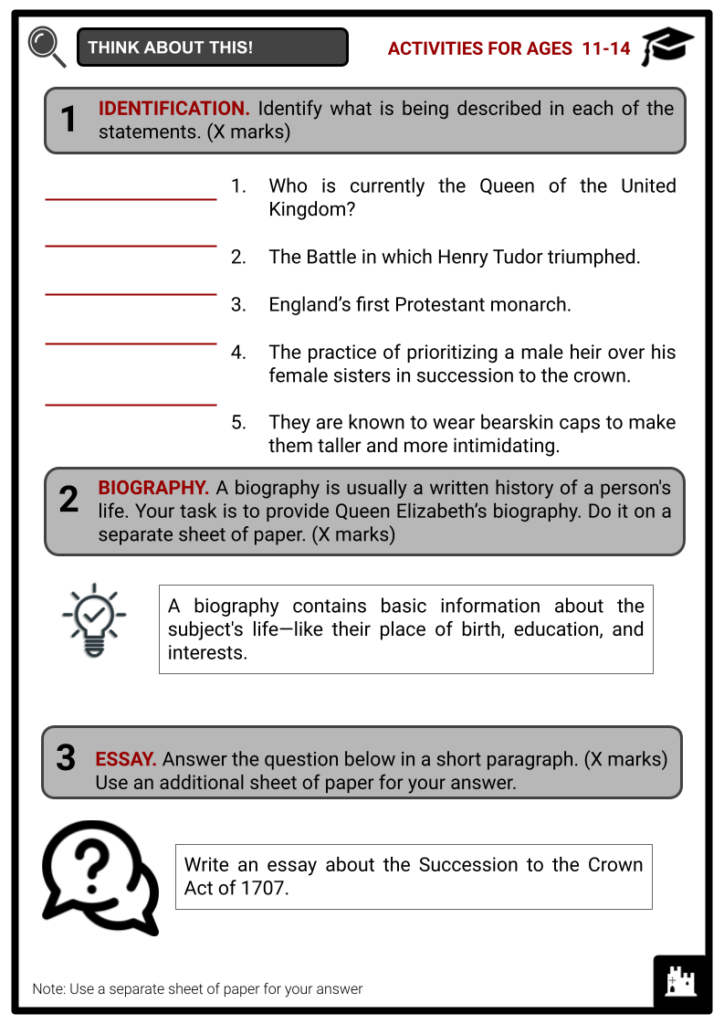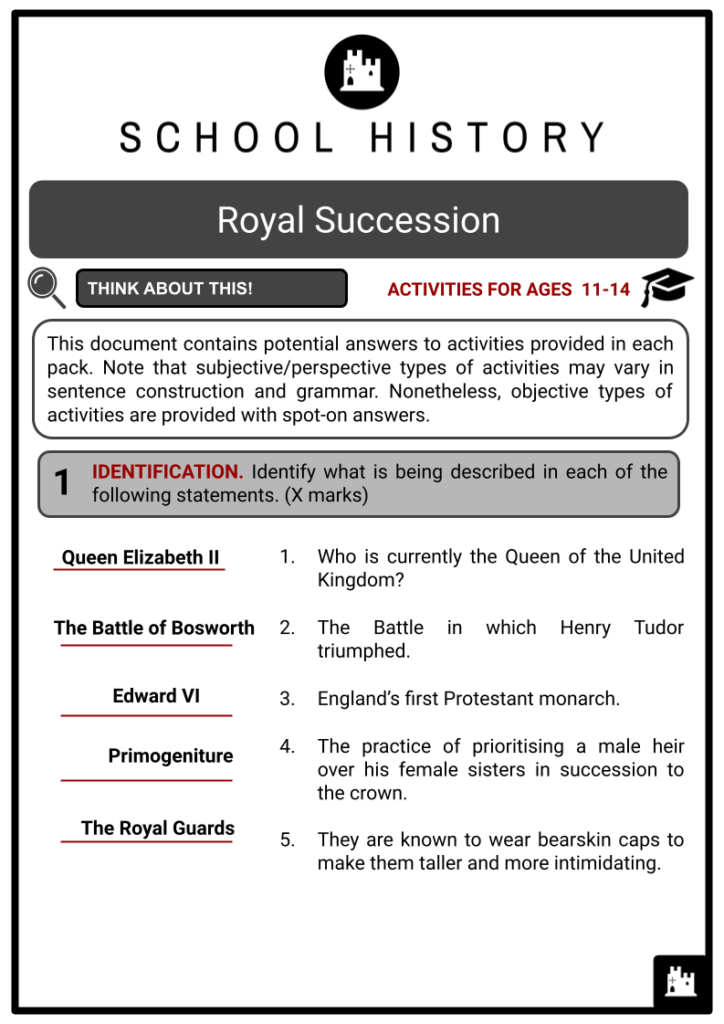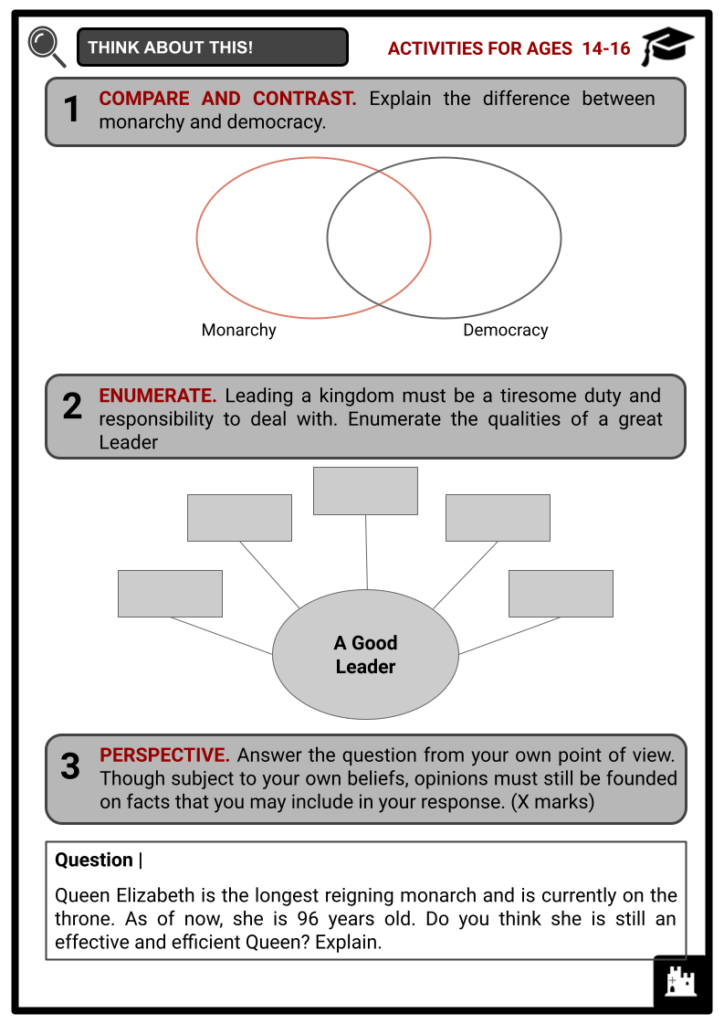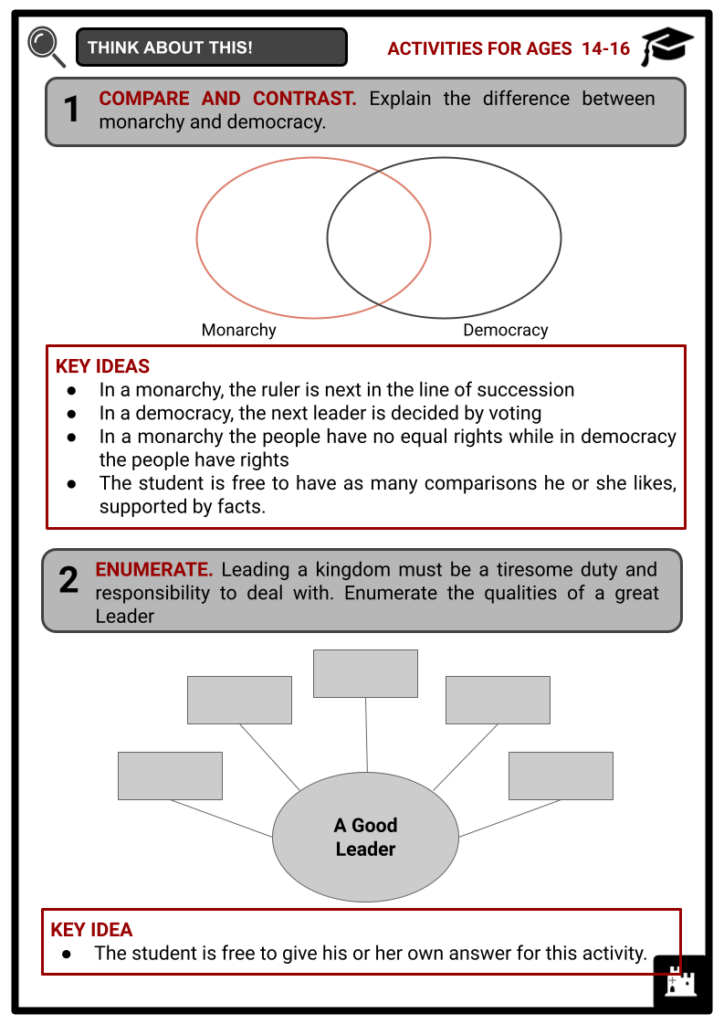Royal Succession Worksheets
Do you want to save dozens of hours in time? Get your evenings and weekends back? Be able to teach about the Royal Succession to your students?
Our worksheet bundle includes a fact file and printable worksheets and student activities. Perfect for both the classroom and homeschooling!
Summary
- History
- Current Rules
- Role of the Royal Family
- Current line of succession
Key Facts And Information
Let’s find out more about the Royal Succession!
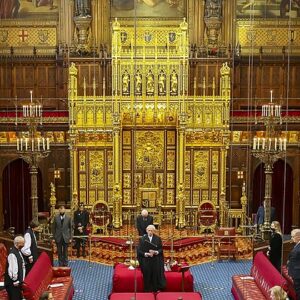
The succession of royal family members in the position in which they are the heir to the throne is known as the order of succession. The crown is inherited by a sovereign's offspring or a barren sovereign's closest relative descended from a sibling of an ancestor. The succession to the crown is governed not just by lineage but also through Parliamentary legislation.
Read more!
Monarchy is a political system based on the full sovereignty or control by a single person. Its succession was often hereditary, thus forming dynastic eras. Monarchies are self-proclaimed or can be elected. Before being abolished by republics in the late 20th century, it was the most customary type of governance.
History
England
- At the Battle of Bosworth, Henry Tudor triumphed over Richard III. He was then crowned King of England in 1485 as Henry VII. He decreed that "The succession of the throne shall be, remained, dwelled, and continued in the most regal person of the then reigning ruler." He was followed by his son Henry VIII, who took the title King of Ireland till the Acts of Union of 1800 unified the crowns into the United Kingdom.
- Henry VIII married six times. He had three children. Mary from his first wife, Catherine of Aragon; Elizabeth (Elizabeth I) from his second marriage to Anne Boleyn, followed by a son, Edward, from his third wife, Jane Seymour. After Henry died in 1547, Edward assumed the throne as Edward VI.
- Edward VI was England's first Protestant monarch. He denied Mary and Elizabeth's claim to the throne by trying to alter the line of succession so that his Catholic half-sister Mary would not accede to the crown. After Edward VI's death in 1553, the Duchess of Suffolk's daughter Lady Jane Grey was named Queen of England and Ireland.
- After nine days, Jane was dethroned by King Edward's older sister, Mary. She preceded her half-sister, Elizabeth, who was imprisoned for over a year on accusations of aiding Protestant insurgents. Queen Elizabeth I did not designate an heir. As queen, one of her first acts was to create an English Protestant church, of which she was declared supreme administrator. Her first cousin, James VI of Scotland, eventually succeeded her and was responsible for the foundation of the Kingdom of Great Britain.
After the Union of the Crowns
- The kingdom was supposed to be passed down to Anne Stanley, heiress of Mary Tudor, Duchess of Suffolk, in accordance with the will of Henry VIII, in which James VI transgressed. As ruler of Scotland, James was formidable enough to prevent any aspirant to the throne. He claimed that inherited rights were greater than legislative provisions. He was succeeded by his eldest son Charles I who was executed in 1649. Oliver Cromwell as Lord Protector became head of state and government.
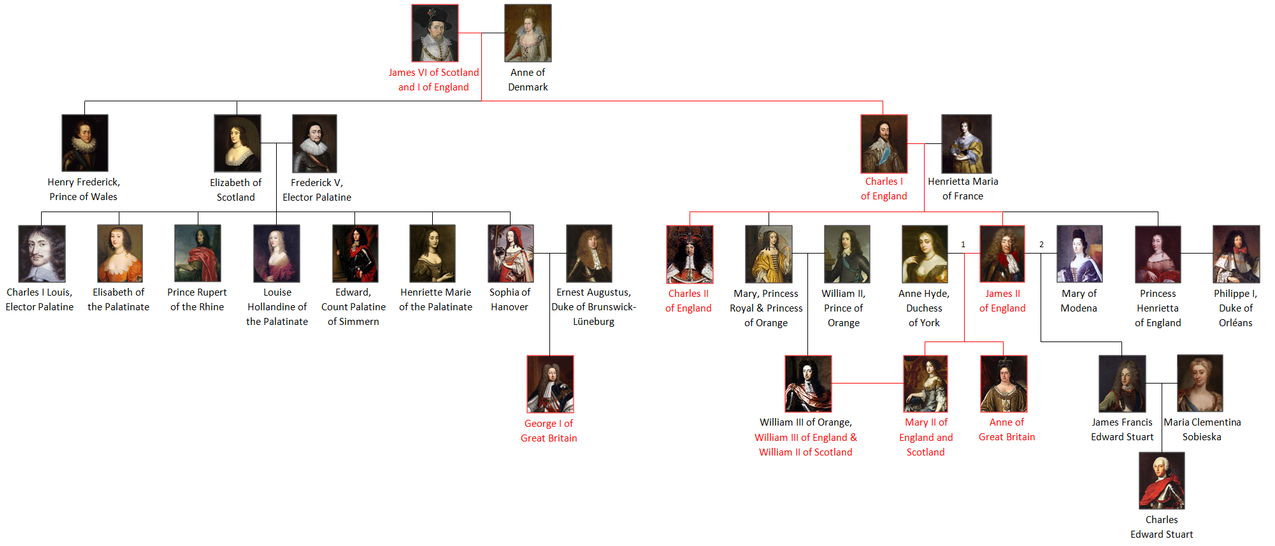
Principal members of the House of Stuart following the 1603 Union of the Crowns. - After Richard Cromwell, the son of Oliver Cromwell, was ousted due to incompetence, the monarchy was reinstated, and Charles II, the son of King Charles I, ascended the throne.
- Charles II had a bastard, James Scott, whom he tried to declare as the next king before his younger brother James II and VII but failed to do so. James II (of England and Ireland) and VII (of Scotland) took over the throne but was forced to flee in 1688 when his opponents deposed him, but doing so the legislature appointed the throne to his daughter Mary II and her husband William III who became the King and Queen of Ireland, Scotland and England.
- Both the Scottish Claim of Rights Act and the English Bill of Rights declared that the next in line was Mary II's descendents. After that came Princess Anne, Mary II's sister, and her successors. And finally her husband’s descendants.
- The Parliament enacted the Act of Settlement, wherein the current Bill of Rights was adopted but added James I and VI's granddaughter, Sophia of Hanover as next in line to the throne. Mary II and William III died without heirs in 1694 and 1702, respectively, leaving the kingdom to Mary II's sister, Princess Anne, and her descendants. Sadly, all of Princess Anne's successors died. Sophia of Hanover became queen after Princess Anne died, and was followed by her son George I in 1714.
Hanoverians and Windsors
- The Hanovers continued to rule the Kingdom of England, notwithstanding the efforts of the Jacobites to reimpose the Stuarts’ right to the throne. George III, King of Great Britain and Ireland, had to be replaced by his son George IV due to an illness. Soon after, his younger brother William IV became King.
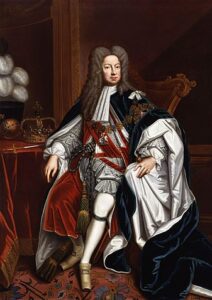
George I - Victoria, William IV's niece, took the throne and was succeeded by her son, Edward VII; after his death, his second son, George V, was proclaimed King; after the death of George V, his son Edward VIII took over, but was forced to abdicate after the disapproval of the people due to his desire to marry an American divorcee, Wallis Simpson. In 1952, he was replaced by his younger brother George VI, followed by George’s elder daughter, Elizabeth II.
Commonwealth Realms
- Elizabeth II was declared sovereign independently in every one of her nation-states upon her accession. Each Commonwealth realm has the same monarch according to the regulations of the Statute of Westminster 1931. Absolute and general aristocracy governs the order of succession for those born after 28th October 2011, and a restriction on marrying Roman Catholics was repealed. The heads of Parliament of all sixteen domain names agreed on proposed amendments to the royal accession statutes in October 2011.
- Elizabeth II is the Queen and Head of State of the Federal Republic of the United Kingdom. Distinct from the rest of the British Isles, each kingdom acts as an autonomous state, equivalent to the Commonwealth's other realms and nations.
Current Rules
Marriage
- Primogeniture is the practice of prioritising a male heir over his female sisters in succession to the crown. The eldest son and his lineage, hold the right to the throne before the younger siblings. Aside from that, according to the Act of Settlement 1701, Protestants were the only ones qualified for accession to the throne. Queen Sophia and her legitimate descendants will continue to hold the kingdom unless legal criteria are not met.
- Marriage without the approval of the Head of State precludes the individual, and their descendants, from inheriting the Crown, although the marriage remains legally recognised. The Royal Marriages Act of 1772 states that the descendants of former King George II are hereby told to seek the authorisation of the incumbent sovereign of England before getting married. The legislation, however, does not apply to the heirs of kings who marry into foreign houses.
- Without the monarch's consent, the person's claim to the throne and bloodline is invalidated, even though the marriage is legally valid. According to the 2013 Succession to the Crown Act, the first six in line to the throne must be granted approval by the enacting monarch at the time.
Read more!
Many spouses of monarchs, illegitimate offspring of monarchs, and monarch relatives of the current rulers have gone on to fight for generations about who has the right to wear the crown. The British Parliament approved the Succession to the Crown Act 1707 in 1707, which excluded illegitimate offspring, Catholics, spouses, and male primogeniture from inheriting the throne. Parliament agreed that Princess Sophia of Hanover should be Queen Anne's successor and that all subsequent British monarchs would be her legal Protestant descendants. She died less than two months before she would have become queen.
Accession
- The heir apparent or heir presumptive accedes to the throne instantly upon the death of a sovereign, with no need for additional ceremony. Nonetheless, the Accession Council meets at St. James's Palace and chooses whether or not to issue the accession proclamation. The occasion is commemorated as Accession Day throughout the monarch's reign and includes flag-flying and royal gun salutes.
Religion
- Kings or Queens of England in the future should be Protestant, and they cannot be christened in the Catholic church. If it happens, they will be disqualified from reigning.
- The Act of Settlement and Bill of Rights forbids any Roman Catholics from inheriting the throne and therefore rejects the concept of switching to Protestantism. Furthermore, anyone who married a Roman Catholic is removed from their claim to the throne. But in 2013 this condition was abolished by the 2013 Succession to the Crown Act.
- A woman who was nominated to succeed Queen Elizabeth II as monarch turned down the chancellery after deciding to become a Catholic. Princess Alexandra of Hanover, a member of the royal family of Monaco, will no longer be entitled to the office of Queen's representative.
- The Archbishop of Canterbury is the latest clergyman of the Church of England to be removed from the line of succession due to his Catholic faith. Lord Nicholas Windsor, George V's grandson, who was accepted into the Catholic Church in 2001 and converted to Roman Catholicism, was the final person to be expelled.
Treason
- The Treason Act of 1702 was passed by the English Parliament to establish the line of succession to the English crown. Any attempt to deny or obstruct any individual who would be next in line to the throne was considered treason. It was one of the most serious acts of treason in British law at the start of the 17th century, having been created by the Bill of Rights 1689 and the Act of Settlement 1701.
Role of the Royal Family
- Despite being known as the Queen or King of England, monarchs do not have complete control over the Kingdoms and territories. The government makes the choices, and he/she is bound by law to follow their advice. The monarch’s principal duties include selecting the Head of State and all other administrations; convening new sessions of government, and granting royal prerogative to laws enacted by parliament.
- A constitutional monarch inherently offers a non-partisan head of state, preventing the highest position of the state from being politicised. It also removes the role of the Head of State from political rivalry and eliminates the requirement for a public vote to select an elected king or queen.
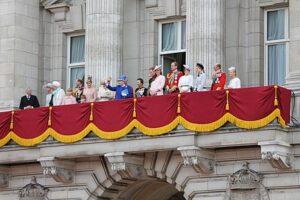
The Royal Family on the balcony at Buckingham Palace. - The Ruler of England and all the other associated realms is also the General in Chief of the Military. He/she legally select the Chancellor and all other members of the government, summons parliament, and grants royal approval to legislation enacted by parliament. Many high posts, such as judges, are also legally appointed by the King/Queen. He/she welcomes and sends forth ambassadors, as well as visiting heads of state, and undertakes overseas state visits.
- In times of transition, the monarchy represents consistency and security. The Royal Family fosters voluntary activity and civil society through patronage and assistance, reaching sectors of the people that politicians do not engage. The Royal Family represents the nation, and different generations in the community may involve a variety of generations of the Royal Family, whether elderly or young.
- Working alone, he/she would be unable to fulfil every involvement to which he/she is asked. Members of the monarchy also assist the King/Queen of the state. When he/she is unable to attend formal engagements overseas, he/she is represented by his/her chosen Royal Family spokesperson. Royal Family members may accept local or specialised engagements on behalf of the King/Queen.
Current Line of Succession
Queen Elizabeth II
- Elizabeth Alexandra Mary, commonly known as Elizabeth II is currently the reigning monarch of the United Kingdom. Born on 21 April 1926,she was the eldest daughter of King George VI. Princess Elizabeth assumed the throne on the year of 1952, months before the death of his father. She is currently 96 years old and the longest-reigning monarch.
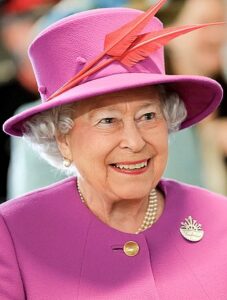
Queen Elizabeth II
Charles, Prince of Wales
- The eldest son of Queen Elizabeth II, Charles Philip Arthur George, Duke of Cornwall, is next in line to the throne. He married Diana Spencer on 29 July 1981. They had two boys, Prince William, born on 21 June 1982, and Prince Harry, born on 15 September 1984. When he ascends to the throne, his eldest son, Prince William, is expected to be the next in line.
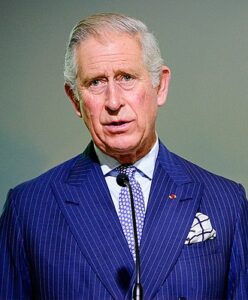
Prince Charles
The Duke of Cambridge
- The eldest son of Prince Charles and Diana, Prince William Arthur Philip Louis is second in line to the throne after his father. He married Catherine Middleton and became the Duchess of Cambridge. They have three children. The eldest, Prince George Alexander Louis, born on 22 July 2013 is next in line after his father.
Did you Know?
Queen Elizabeth is guarded by the Royal Guards throughout the palace. They are known to wear bearskin caps to make them taller and more intimidating. Their main duty is to protect the monarch at all times and other royal landmarks.
Prince George
- George Alexander Louis, the eldest son of Prince William, was born on 22 July 2013. Currently eight years old, he is third in line to the throne with his siblings Princess Charlotte and Prince Louis as fourth and fifth in line to the throne.
The Duke of Sussex
- Currently sixth in line to the throne is Prince Harry, the Duke of Sussex. He is the younger brother of Prince William, the son of Prince Charles, who is currently second in line to the throne, and Diana, Princess of Wales. Prince Harry married Meghan Markle, an American actress and had two children, Archie and Lilibet Mountbatten-Windsor, seventh and eighth in line to the throne.
The Duke of York
- Prince Andrew, the Duke of York, ninth in line, is the third child of Queen Elizabeth II and Prince Philip. Andrew Albert Christian Edward was born on 19 February 1960 in Buckingham Palace, London. He married Sarah Ferguson on 23 July 1986 and had two daughters, Princess Beatrice and Princess Eugenie.
- After Prince Andrew is Princess Beatrice (Mrs Edoardo Mapelli Mozzi), Miss Sienna Mapelli Mozzi, Princess Eugenie (Mrs Jack Brooksbank), Master August Brooksbank, Prince Edward, the Earl of Wessex, Viscount Severn, Lady Louise Mountbatten-Windsor, Anne, Princess Royal, Mr Peter Phillips, Miss Savannah Phillips, Miss Isla Phillips, Zara Tindall (Mrs Michael Tindall), Miss Mia Tindall, Miss Lena Tindall, and Master Lucas Tindall.
Image Sources
- https://upload.wikimedia.org/wikipedia/commons/thumb/7/7b/Sovereign%27s_Throne%2C_House_of_Lords.jpg/420px-Sovereign%27s_Throne%2C_House_of_Lords.jpg
- https://upload.wikimedia.org/wikipedia/commons/thumb/6/6e/House_of_Stuart.png/1275px-House_of_Stuart.png
- https://upload.wikimedia.org/wikipedia/commons/thumb/0/02/King_George_I_by_Sir_Godfrey_Kneller%2C_Bt_%283%29.jpg/337px-King_George_I_by_Sir_Godfrey_Kneller%2C_Bt_%283%29.jpg
- https://upload.wikimedia.org/wikipedia/commons/thumb/5/58/The_British_royal_family_on_the_balcony_of_Buckingham_Palace.JPG/455px-The_British_royal_family_on_the_balcony_of_Buckingham_Palace.JPG
- https://upload.wikimedia.org/wikipedia/commons/thumb/b/b6/Queen_Elizabeth_II_in_March_2015.jpg/330px-Queen_Elizabeth_II_in_March_2015.jpg
- https://upload.wikimedia.org/wikipedia/commons/thumb/4/4f/Charles%2C_Prince_of_Wales_at_COP21.jpg/330px-Charles%2C_Prince_of_Wales_at_COP21.jpg

